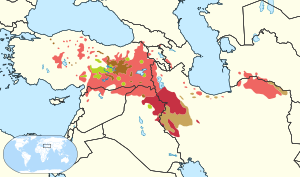Kurdish phonology facts for kids
Kurdish phonology is the sound system of the Kurdish dialect continuum. This article includes the phonology of the three largest Kurdish dialects in their respective standard descriptions. Phonological features include the distinction between aspirated and unaspirated voiceless stops, and the large phoneme inventories.
Contents
Consonants

Geographic distribution of Kurdish dialects Kurmanji (Northern Kurdish) Sorani (Central Kurdish) Zaza language Southern Kurdish (Gorani is included) mixed dialect areas
| Labial | Dental/ Alveolar |
Palatal | Velar | Uvular | Pharyngeal | Glottal | ||||||
|---|---|---|---|---|---|---|---|---|---|---|---|---|
| plain | velar. | plain | labial. | plain | labial. | plain | labial. | |||||
| Nasal | ||||||||||||
| Plosive | voiceless asp. | |||||||||||
| vcls. unasp. | ||||||||||||
| voiced | ||||||||||||
| Fricative | voiceless | |||||||||||
| voiced | ||||||||||||
| Approximant | ||||||||||||
| Rhotic | ||||||||||||
- are laminal denti-alveolar [], while are dentalized laminal alveolar [], pronounced with the blade of the tongue very close to the back of the upper front teeth, with the tip resting behind lower front teeth.
- Kurdish contrasts plain alveolar and velarized postalveolar lateral approximants. Unlike in English, the sounds are separate phonemes rather than allophones.
- Postvocalic is lenited to an approximant. This is a regional feature occurring in other Iranian languages as well and called by Windfuhr the "Zagros d".
- Kurdish has two rhotic sounds; the alveolar flap and the alveolar trill. While the former is alveolar, the latter has an alveo-palatal articulation.
Kurmanji Kurdish
- Distinguishes between aspirated and unaspirated voiceless stops, which can be aspirated in all positions. Thus contrasts with with with and the affricate with.
- Although is considered an allophone of some phonologists argue that it should be considered a phoneme.
Sorani Kurdish
- According to Hamid (2015) are uvular.
- Distinguishes between the plain and and the velarized and. These velarized counterparts are less emphatic than the Semitic emphatic consonants.
Southern Kurdish
- is an allophone of occurring in the about 11 to 19 words that have the consonant group ⟨nz⟩. The word yânza is pronounced as.
Labialization
- Kurdish has labialized counterparts to the velar plosives, the voiceless velar fricative and the uvular stop. Thus contrasts with with with and with. These labialized counterparts do not have any distinct letters or digraph. Examples are the word xulam ('servant') which is pronounced as and qoç ('horn') is pronounced as.
Palatalization
- After is palatalized to. An example is the Central Kurdish word gâlta ('joke'), which is pronounced as.
- and are strongly palatalized before the front vowels and as well as becoming acoustically similar to and.
- When preceding are palatalized to. In the same environment also becomes.
Pharyngealization
- In some cases are pharyngealized to. For example, the word sed/ṣed is pronounced as
- Furthermore, while and are unique to Central Kurdish, Kurmanji has.
Consonants in loanwords
- is a phoneme that is almost exclusively present in words of Arabic origin. It is often replaced by in colloquial Kurdish. Thus the word xerîb/ẍerîb ('stranger') may occur as either or.
- mostly occurs in words of Arabic origin, mostly in word-initial position.
- is mainly present in Arabic loanwords and it affects the pronunciation of adjacent vowels. The use of the glottal stop in everyday Kurdish may be seen as an effort to highlight its Arabic source.
Vowels
The vowel inventory differs by dialect, some dialect having more vowel phonemes than others. The vowels are the only phonemes present in all three Kurdish dialects.
| Front | Central | Back | |||
|---|---|---|---|---|---|
| unrounded | rounded | unrounded | rounded | ||
| Close | |||||
| Close-mid | |||||
| Open-mid | |||||
| Open | |||||
Detailed table
| Grapheme | Phoneme | ||
|---|---|---|---|
| Kurmanji | Central | Southern | |
| a | |||
| â | – | ||
| e | |||
| ê | |||
| i | |||
| î | |||
| o | |||
| ô | – | – | |
| ö | – | – | |
| u | |||
| û | |||
| ü | – | – | |
Vowels in loanwords=
- occurs in numerous dialects of Central Kurdish where it is represented by wê/وێ, as well as in Southern Kurdish, represented by ⟨ö⟩. In Kurmanji, it is only present in loanwords from Turkish, where it often merges with. The word öks (from Turkish ökse meaning 'clayish mud') is pronounced as either or.
Glides and diphthongs
The glides and appear in syllable onsets immediately followed by a full vowel. All combinations except the last four are present in all three Kurdish dialects.
| IPA | Spelling | Example Word | Dialect Group | ||||
|---|---|---|---|---|---|---|---|
| Kurmanji | Central | Southern | |||||
| aw | şaw | 'night' (Central Kurdish) | |||||
| âw | çaw | 'eye' (Central Kurdish) | |||||
| ây | çay | 'tea' | |||||
| ew | kew | 'partridge' | |||||
| ey | peynja | 'ladder' | |||||
| oy | birôyn | 'let's go' (Central Kurdish) | |||||
| ûy | çûy | 'went' (Central Kurdish) | |||||
| a | da | 'ogre' (Southern Kurdish) | |||||
| ü | küa | 'mountain' (Southern Kurdish) | |||||
| e | tela | 'stable' (Southern Kurdish) | |||||
| a | dat | 'daughter' (Southern Kurdish) | |||||

All content from Kiddle encyclopedia articles (including the article images and facts) can be freely used under Attribution-ShareAlike license, unless stated otherwise. Cite this article:
Kurdish phonology Facts for Kids. Kiddle Encyclopedia.
